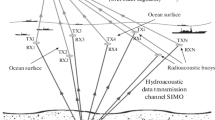Abstract
Field investigations of the influence of a drifting ice cover on the probability of bit errors in a hydroacoustic communication channel constructed by the orthogonal frequency-division multiplexing (OFDM) technology were carried out. Quantitative estimates of the effect of drifting ice on a multifrequency phase-modulated OFDM signal reflected from the lower ice surface have been determined. The negative influence is seen in the broadening of the carrier frequency spectrum and in the reduction of the mutual correlation of phase-frequency shifts between carrier frequencies at the reception point. As a result of the spectrum broadening and jump-like changes in the phase of information signals, there is a sharp increase in the probability of bit errors during the reception. Methods are proposed for choosing optimum broadband OFDM-signal parameters allowing the negative influence of the ice cover to be neutralized and the signal transmission through a hydroacoustic communication channel with given characteristics to be implemented.





Similar content being viewed by others
REFERENCES
A. S. Shustov and A. E. Kutsko, in Proc. 13th All-Russian Conference “Applied Technologies for Hydro-Acoustics and Hydro-Physics” (St. Petersburg, 2016).
K. Prashant and K. Preetam, in Proc. IEEE Int. Conference on Communications, 2013: IEEE ICC'13–Workshop on Radar and Sonar Network (Budapest, 2013), p. 977.
I. A. Aleksandrov, Akust. Zh. 40 (4), 673 (1994).
G. S. Malyshkin and A. V. Shafranyuk, Acoust. Phys. 59 (5), 565 (2013).
G. S. Malyshkin and G. B. Sidel’nikov, Acoust. Phys. 60 (5), 570 (2014).
Theory of Sound Reflection. Physical Encyclopedia (Great Russian Encyclopedia, Moscow, 1992), Vol. 3, p. 504 [in Russian].
C. Polprasert, J. A. Ritcey, and M. Stojanovic, IEEE J. Oceanic Eng. 36 (4), 514 (2011). doi 10.1109/ JOE.2011.2167071
J. Huang, C. R. Berger, S. Zhou, and J. Huang, in Proc. OCEANS 2010 IEEE Conference (Sidney, 2010), p. 24.
D. F. Hoag, V. K. Ingle, and R. J. Gaudette, IEEE J. Oceanic Eng. 22 (2), 393 (1997).
M. Stojanovic, in Proc. IEEE Int. Conference on Acoustics, Speech and Signal Processing (Las Vegas, NV, 2008), p. 5288.
K. Le Page and H. Schmidt, J. Acoust. Soc. Am. 99 (4), 2033 (1996).
J. Trubuil, A. Goalic, and N. Beuzelin, in Proc. OCEANS 2008 IEEE Conference (Quebec City, 2008), p. 1.
W. Zhaohui, Z. Shengli, J. C. Preisig, K. R. Pattipati, and P. Willett, IEEE Trans. Signal Process. 60 (6), 3079 (2012).
Y. Labrador, M. Karimi, D. Pan, and J. Miller, Int. J. Comput. Sci. Network Secur. 9 (7), 123 (2009).
V. M. Timets, G. I. Vilkov, and R. A. Balakin, RF Patent No. 2597687, Byull. Izobret., No. 2.6 (2016).
F. De Rango, F. Veltri, and P. Fazio, in Proc. IEEE Int. Conference on Communications (Ottawa, 2012), p. 3811.
Tong Xuejian and Tao Luo, Theory and Application of OFDM Mobile Communication Technology (Posts and Telecommunications Press, Beijing, 2003).
Y. R. Zheng, in Proc. IEEE Military Communications Conference (Orlando, FL, 2007), p. 1.
Ice Profiling Sonar (IPS)TM. https://www.aslenv. com/brochures/IPS-Brochure.pdf.
Workhorse Monitor ADCP. http://www.teledynemarine.com/workhorse-monitor-adcp?ProductLineID=12.
ACKNOWLEDGMENTS
The study was supported by the Ministry of Education and Science of the Russian Federation within the framework of applied scientific research according to the federal special purpose program “Research and Development in Priority Guidelines of the Scientific and Technological Complex of Russia for 2014–2020,” agreement on subsidy no. 14.607.21.0009 of June 5, 2014 (project unique identifier RFMEFI60714X0009).
Author information
Authors and Affiliations
Corresponding authors
Additional information
Translated by A. Nikol’skii
Rights and permissions
About this article
Cite this article
Balakin, R.A., Vilkov, G.I. Adaptation of a Hydroacoustic Communication Channel with OFDM Technology to the Negative Influence of a Drifting Ice Cover. Acoust. Phys. 65, 208–215 (2019). https://doi.org/10.1134/S1063771019020039
Received:
Revised:
Accepted:
Published:
Issue Date:
DOI: https://doi.org/10.1134/S1063771019020039




